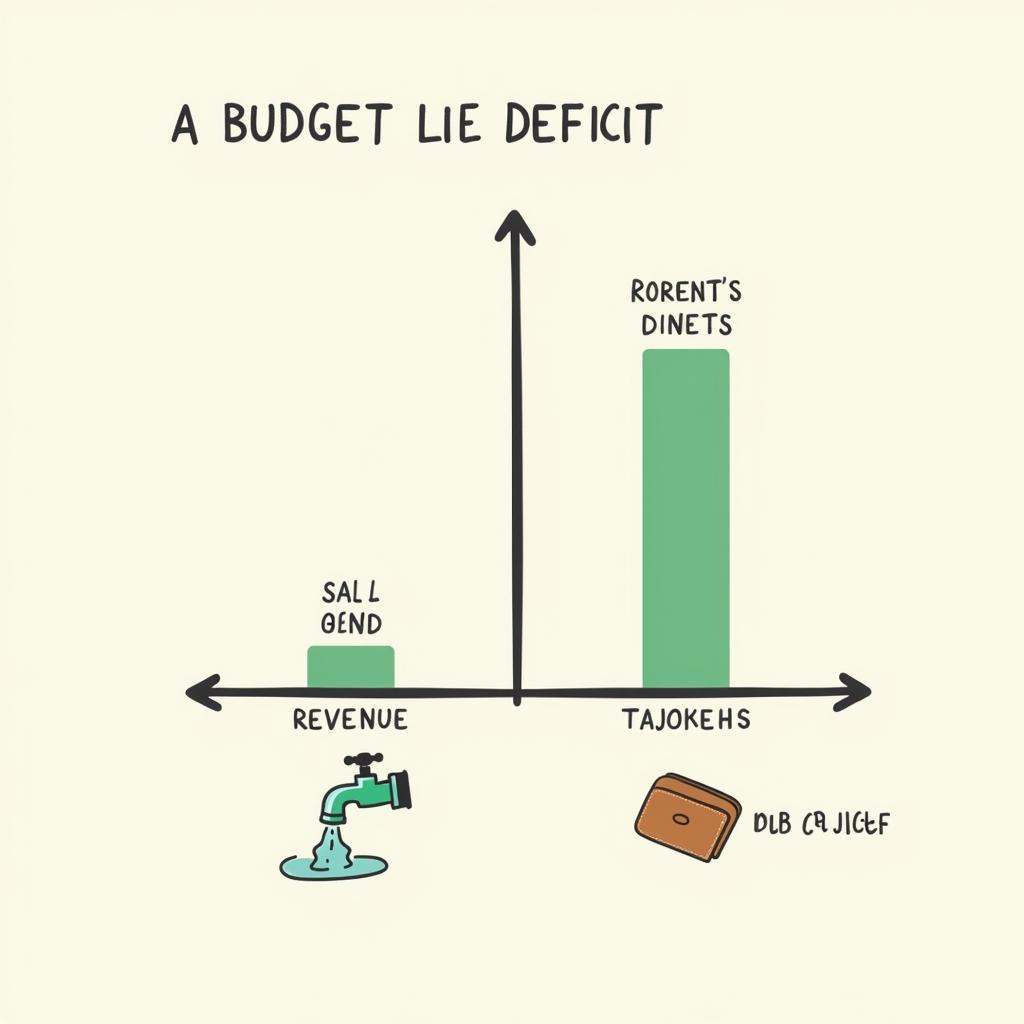National debt and deficit are two terms often used interchangeably, but they represent distinct concepts in economics. Understanding the difference between national debt vs. deficit is crucial for grasping a country’s financial health. A deficit represents the shortfall in a given year’s budget, while the debt is the accumulation of past deficits.
What is a Budget Deficit?
A budget deficit occurs when a government spends more money than it brings in through revenue (like taxes) during a specific period, typically a fiscal year. Think of it like spending more than you earn in a month – you’ll need to borrow to cover the difference. This borrowing contributes to the national debt. Several factors can contribute to a deficit, including increased government spending on social programs, defense, or infrastructure projects, or a decrease in tax revenue due to economic downturns.
 Hình ảnh minh họa ngân sách thiếu hụt
Hình ảnh minh họa ngân sách thiếu hụt
Several factors can lead to increased deficits, including tax cuts, increased government spending, economic downturns, and unexpected events like natural disasters. Understanding the underlying causes of a deficit is essential for developing effective policies to address it.
What is National Debt?
The national debt is the total accumulation of past budget deficits. It’s the total amount of money a government owes to lenders, both domestic and international. This debt is accumulated over time as the government borrows to cover its spending. This can be a useful tool to fund important investments, but excessive debt can become a burden.
The national debt is often expressed as a percentage of a country’s Gross Domestic Product (GDP), which provides a relative measure of the debt burden. A high debt-to-GDP ratio can indicate potential economic instability.
Key Differences between National Debt and Deficit
While interconnected, the deficit and debt are distinct. The deficit is a flow variable, measuring the difference between spending and revenue over a period. The debt is a stock variable, representing the accumulated total owed at a point in time.
How are they related?
A persistent budget deficit adds to the national debt. Think of it like adding water to a bathtub: the deficit is the water flowing in, and the debt is the total amount of water in the tub. If the inflow (deficit) is greater than the outflow (surplus or debt reduction), the tub (national debt) fills up.
Managing National Debt and Deficits
Governments employ various strategies to manage debt and deficits. These can include fiscal policies like raising taxes or cutting spending, as well as monetary policies aimed at controlling inflation. Finding the right balance is a complex challenge, often influenced by political and economic factors.
Conclusion
Understanding the difference between national debt vs. deficit is vital for informed economic discussions. While a budget deficit contributes to the national debt, managing both requires a comprehensive understanding of their relationship and the factors driving them. By understanding these key concepts, we can better analyze government financial policies and their long-term economic impacts.
FAQ
- What is the current U.S. national debt? This figure fluctuates constantly. You can find up-to-date information from reliable sources like the U.S. Treasury Department.
- Is a national debt always bad? Not necessarily. Some level of debt can be manageable and even beneficial for investments. However, excessive debt can hinder economic growth.
- How can a country reduce its national debt? Through a combination of fiscal policies (like spending cuts or tax increases) and measures to stimulate economic growth.
- What are the consequences of a high national debt? Potential consequences include higher interest rates, reduced government spending on essential services, and increased inflation.
- What is the difference between a budget deficit and a trade deficit? A budget deficit refers to government spending exceeding revenue, while a trade deficit means a country imports more than it exports.
- How does national debt affect individuals? Potentially through higher taxes, reduced government services, and economic instability.
- What is debt ceiling? A legislative limit on the amount of national debt a government can accumulate.
Gợi ý các câu hỏi khác, bài viết khác có trong web:
- Bạn muốn tìm hiểu thêm về lạm phát? Xem bài viết “Lạm phát là gì?”
- Bạn quan tâm đến GDP? Đọc bài viết “GDP: Định nghĩa và Tầm quan trọng”
Khi cần hỗ trợ hãy liên hệ Số Điện Thoại: 0372999888, Email: [email protected] Hoặc đến địa chỉ: 236 Cầu Giấy, Hà Nội. Chúng tôi có đội ngũ chăm sóc khách hàng 24/7.